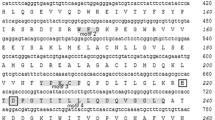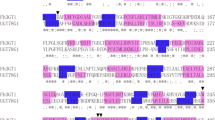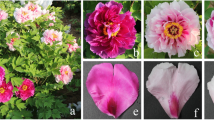Abstract
The expression, during flower development, of the gene encoding the anthocyanin pathway key enzyme dihydroflavonol 4-reductase (DFR) was investigated in floral organs of Forsythia × intermedia cv. ‘Spring Glory’. Full-length DFR and partial chalcone synthase (CHS) cDNAs, the gene of interest and a flavonoid pathway control gene respectively, were obtained from petal RNA by reverse transcription PCR. Whereas for CHS northern blot analysis enabled the study of its expression pattern, competitive PCR assays were necessary to quantify DFR mRNA levels in wild-type plants and in petals of 2 transgenic clones containing a CaMV 35S promoter-driven DFR gene of Antirrhinum majus. Results indicated a peak of CHS and DFR transcript levels in petals at the very early stages of anthesis, and different expression patterns in anthers and sepals. In comparison to wild-type plants, transformants showed a more intense anthocyanin pigmentation of some vegetative organs, and a dramatic increase in DFR transcript concentration and enzymatic activity in petals. However, petals of transformed plants did not accumulate any anthocyanins. These results indicate that other genes and/or regulatory factors should be considered responsible for the lack of anthocyanin production in Forsythia petals.
Similar content being viewed by others
References
Baurens JC, Noyer JL, Lanaud C, Lagoda PJL: Use of competitive PCR to assay copy number of repetitive elements in banana. Mol Gen Genet 253: 57-64 (1996).
Beld M, Martin C, Huits H, Stuitje AR, Gerats AGM: Flavonoid synthesis in Petunia hybrida: partial characterization of dihydroflavonol-4-reductase genes. Plant Mol Biol 13: 491- 502 (1989).
Berberich T, Sugawara K, Harada M, Kusano T: Molecular cloning, characterization and expression of an elongation factor 1 alpha in maize. Plant Mol Biol 29: 611-615 (1995).
Bongue-Bartelsman M, O'Neill SD, Tong Y, Yoder JI: Characterization of the gene encoding dihydroflavonol 4-reductase in tomato. Gene 138: 153-157 (1994).
Charrier B, Coronado C, Kondorosi A, Ratet P: Molecular characterization and expression of alfalfa (Medicago sativaL.) flavanone-3-hydroxylase and dihydroflavonol-4-reductase. Plant Mol Biol 29: 773-786 (1995).
Chevet E, Lemaître G, Doron Katinka M: Low concentrations of tetramethylammonium chloride increase yield and specificity of PCR. Nucl Acids Res 23: 3343-3344 (1995).
Chulia AJ, Tissut M: Accumulation des flavonols et activité PAL, dans la fleur de Forsythiaet la feuille de maīs, en salle conditionnée. Z Pflanzenphysiol 74: 404-414 (1975).
Dellus V, Heller W, Sandermann H, Scalbert A: Dihydroflavonol 4-reductase activity in lignocellulosic tissues. Phytochemistry (submitted).
Feinbaum RL, Ausubel FM: Transcriptional regulation of the Arabidopsis thalianachalcone synthase gene. Mol Cell Biol 8: 1985-1992 (1988).
Frohman MA, Dush MK, Martin GR: Rapid production of full-length cDNAs from rare transcripts: amplification using a single gene-specific oligonucleotide primer. Proc Natl Acad Sci USA 85: 8998-9002 (1988).
Gilliland G, Perrin S, Bunn HF: Competitive PCR for quantitation of mRNA. In Innis MA, Gelfand DH, Sninsky JJ, White TJ (eds) PCR protocols: a guide to method and applications, pp. 60-70. Academic Press, San Diego (1990).
Giuliano G, Bartley GE, Scolnik PA: Regulation of carotenoid biosynthesis during tomato development. Plant Cell 5: 379- 387 (1993).
Helariutta Y, Elomaa P, Kotilainen M, Seppänen P, Teeri TH: Cloning of cDNA coding for dihydroflavonol-4-reductase (DFR) and characterization of dfrexpression in the corollas of Gerbera hybridavar. Regina (Compositae). Plant Mol Biol 22: 183-193 (1993).
Heller W, Forkmann G: Biosynthesis of flavonoids. In: Harborne JB (ed) The Flavonoids: Advances in Research Since 1986, pp. 499-535. Chapman & Hall, London (1993).
Heller W, Forkmann G, Britsch L, Grisebach H: Enzymatic reduction of (+)-dihydroflavonols to flavan-3,4-cis-diols with flower extracts from Matthiola incanaand its role in anthocyanin biosynthesis. Planta 165: 284-287 (1985).
Holton TA, Cornish EC: Genetic and biochemistry of anthocyanin biosynthesis. Plant Cell 7: 1071-1083 (1995).
Hood EE, Helmer GL, Frayley RT, Chilton MD: The hyper-virulence of Agrobacterium tumefaciensA281 is encoded in a region of pTiBO542 outside the T-DNA. J Bact 168: 1297- 1301 (1986).
Junghans H, Dalkin K, Dixon RA: Stress responses in alfalfa (Medicago sativaL.). 15. Characterization and expression patterns of members of a subset of the chalcone synthase multigene family. Plant Mol Biol 22: 239-253 (1993).
Koes RE, Quattrocchio F, Mol JMN: The flavonoid biosynthetic pathway in plants: function and evolution. Bioessays 16: 123-132 (1994).
Kristiansen KN, Rohde W: Structure of the Hordeum vulgaregene encoding dihydroflavonol-4-reductase and molecular analysis of ant18mutants blocked in flavonoid synthesis. Mol Gen Genet 230: 49-59 (1991).
Lee CC, Wu X, Gibbs RA, Cook RG, Muzny DM, Caskey CT: Generation of cDNA probes directly by amino acid sequence: cloning of urate oxidase. Science 239: 1288-1291 (1988).
Liboz T, Bardet C, Le Van Thai A, Axelos M, Lescure B: The four members of the gene family encoding the Arabidopsis thalianatranslational elongation factor EF-1 alpha are actively transcribed. Plant Mol Biol 14: 107-110 (1990).
Lurin C, Jouanin L: RFLP of RT-PCR products: application to the expression of CHSmultigene family in poplar. Mol Breed 1: 411-417 (1995).
Mahe A, Grisvard J, Dron M: Fungal-and plant-specific gene markers to follow the bean anthracnose infection process and normalize a bean chitinase mRNA induction. Mol Plant-Microbe Inter 5: 242-248 (1992).
Meyer P, Heidmann I, Forkmann G, Saedler H: A new petunia flower colour generated by transformation of a mutant with a maize gene. Nature 330: 677-678 (1987).
Nicholson P, Lees AK, Maurin N, Parry DW, Rezanoor HN: Development of a PCR assay to identify and quantify Microdochium nivalevar. nivaleand Microdochium nivalevar. majusin wheat. Physiol Mol Plant Path 48: 257-271 (1996).
O'Neill SD, Tong Y, Sporlein B, Forkmann G, Yoder JI: Molecular genetic analysis of the chalcone synthase in Lycopersicon esculentumand an anthocyanin-deficient mutant. Mol Gen Genet 224: 279-288 (1990).
Pollack PE, Vogt T, Mo Y, Taylor LP: Chalcone synthase and flavonoid accumulation in stigmas and anthers of Petunia hybrida. Plant Physiol 102: 925-932 (1993).
Polkaski AR, Hiatt WR, Ridge N, Rasmussen R, Houck CM, Shewmaker CK: Structure and expression of elongation factor 1 alpha in tomato. Nucl Acids Res 17: 4661-4673 (1989).
Rosati C, Cadic A, Renou JP, Duron M: Regeneration and Agrobacterium-mediated transformation of Forsythia× intermedia"spring Glory’. Plant Cell Rep 16: 114-117 (1996).
Sambrook J, Fritsch EF, Maniatis T: Molecular Cloning: A Laboratory Manual, 2nd ed. Cold Spring Harbor Laboratory Press, Cold Spring Harbor, NY (1989).
Sampson DR: Mating group ratios in distylic Forsythia(Oleaceae). Can J Genet Cytol 13: 368-371 (1971).
Sparvoli F, Martin C, Scienza A, Gavazzi G, Tonelli C: Cloning and molecular analysis of structural genes involved in flavonoid and stilbene synthesis in grape (Vitis viniferaL.). Plant Mol Biol 24: 743-755 (1994).
Schwarz-Sommer Z, Shepherd N, Tacke E, Gierl A, Rohde W, Leclerq L, Mattes M, Berndtgen R, Peterson PA, Saedler H: Influence of transposable elements on the structure and function of the A1 gene of Zea mays. EMBO J 6: 287-294 (1987).
Shirley BW, Hanley S, Goodman HM: Effects of ionizing radiation on a plant genome: analysis of two Arabidopsistransparent testa mutations. Plant Cell 4: 333-347 (1992).
Sommer H, Saedler H: Structure of the chalcone synthase gene of Antirrhinum majus. Mol Gen Genet 202: 429-434 (1986).
Tanaka Y, Fukui Y, Fukuchi-Mizutani M, Holton TA, Higgins E, Kusumi T: Molecular cloning and characterization of Rosa hybridadihydroflavonol 4-reductase gene. Plant Cell Physiol 36: 1023-1031 (1995).
Wienand U, Weydemann U, Niesbach-Klösgen U, Peterson PA, Saedler H: Molecular cloning of the c2locus of Zea mays, the gene coding for chalcone synthase. Mol Gen Genet 203: 202-207 (1986).
Author information
Authors and Affiliations
Rights and permissions
About this article
Cite this article
Rosati*, C., Cadic, A., Duron, M. et al. Molecular cloning and expression analysis of dihydroflavonol 4-reductase gene in flower organs of Forsythia × intermedia. Plant Mol Biol 35, 303–311 (1997). https://doi.org/10.1023/A:1005881032409
Issue Date:
DOI: https://doi.org/10.1023/A:1005881032409




